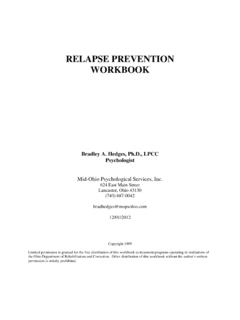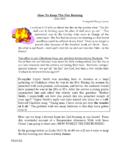Transcription of Bury My Heart at Wounded Knee
1 bury My Heart at Wounded KneeBy Dee BrownCopyright NoticeSome or all of these eNotes are an offprint from Gale's For Students Series: Presenting Analysis, Context, andCriticism on Commonly Studied Works. 1998 2002; 2002 by Gale. Gale is an imprint of The Gale Group, Inc., a division of Thomson Learning,Inc. Gale and Design and Thomson Learning are trademarks used herein under license. 2005 LLCALL RIGHTS part of this work covered by the copyright hereon may be reproduced or used in any form or by any meansgraphic, electronic, or mechanical, including photocopying, recording, taping, Web distribution or informationstorage retrieval systems without the written permission of the complete copyright information on these eNotes please visit: of ContentsBury My Heart at Wounded knee : Introduction1.
2 Dee Brown Biography2. One Page Summary3. Summary and Analysis4. Quizzes5. Characters6. Themes7. Style8. Historical Context9. Critical Overview10. Essays and Criticism11. Suggested Essay Topics12. Sample Essay Outlines13. Compare and Contrast14. Topics for Further Study15. Media Adaptations16. What Do I Read Next?17. Bibliography and Further Reading18. IntroductionDee Brown's bury My Heart at Wounded knee was first published in the United States in 1970. Thislandmark book which incorporated a number of eyewitness accounts and official records offered ascathing indictment of the politicians, soldiers, and citizens who colonized the American West. FocusingBury My Heart at Wounded Knee1mainly on the thirty year span from 1860 to 1890, the book was the first account of the time period told fromthe Native American point of view.
3 It demonstrated that whites instigated the great majority of the conflictsbetween Native Americans and themselves. Brown began searching for the facts about Native Americans afterhe met several as a child and had a hard time believing the myths about their savagery that were popularamong white people. Brown published his book a century after the events took place, but it was a timelypublication, since many citizens were already feeling guilty about their country's involvement in theVietnam War. Brown's book depicted, in detail, the government's attempt to acquire Native Americans'land by using a mix of threats, deception, and murder. In addition, the book showed the attempts to crushNative American beliefs and practices.
4 These acts were justified by the theory of Manifest Destiny, whichstated that European descendents acting for the government had a God given right to take land from theNative Americans. bury My Heart at Wounded knee is Brown's best known work and has sinceovershadowed all of his other books. Back to Table of ContentsAuthor BiographyDee Brown was born on February 28, 1908, in Alberta, Louisiana. He grew up in Arkansas, where he metmany Native Americans. He found it hard to believe the myths of Native American savagery and readeverything he could find about the real history of the American West. Since he was pursuing a career as alibrarian at the same time, he frequently had access to the materials he needed.
5 At George WashingtonUniversity, he studied library science and worked as a library assistant for the United States Department ofAgriculture. After receiving his bachelor's degree in library science in 1937, Brown held his first librarianposition at the Beltsville Research Center (1940 1942).In 1942, he published his first novel, Wave High the Banner, a historical novel based on the life andadventures of Davy Crockett, the legendary frontiersman. Over the next few decades, Brown wrote severalmore novels and nonfiction books about the American West and earned his master's degree from theUniversity of Illinois (1952). He also worked as a librarian for the United States War Department and theUniversity of Illinois, ultimately becoming a professor of library science at the university from 1962 to , despite all of these accomplishments, it was Brown's 1970 publication of bury My Heart atWounded knee that made him a household name.
6 After that, Brown published several works, including anonfiction book, Wondrous Times on the Frontier (1993); a collection of autobiographical writings, When theCentury Was Young: A Writer's Notebook (1993); and a novel, The Way to Bright Star (1998). However, noneof these works received the attention or praise of bury My Heart at Wounded knee , which is still Brown'sbest known work. Brown lives and works in Little Rock, Arkansas. Back to Table of ContentsOne page SummaryChapter 1: Their Manners are Decorous and Praiseworthy bury My Heart at Wounded knee begins with an overview of the relations between Native Americans andwhite settlers from the late 1400s to the mid 1800s. Initially peaceful, these relations become more tense aswhite emigration from Europe to the United States 2: The Long Walk of the NavahosThe government wants Navaho land for settlements and mining, so the Army kills or displaces allMescalero Apaches and Navahos in the region.
7 Many Navahos die when they are forced to live at the BosqueRedondo reservation. Ultimately, the Navahos sign a peace treaty and are allowed to return to what is left oftheir 3: Little Crow's WarManipulated by deceptive treaties, the Santee Sioux surrender most of their land for money and provisionsthey mostly do not receive. Little Crow does not want to fight the military might of the United States but hasno choice when some of his men kill white settlers. The Santees are ultimately overpowered by the Army andby a Santee 4: War Comes to the CheyennesWhite settlers ignore a treaty and begin settling on Native American territory. After Cheyennes and Arapahosmeet with the Colorado governor to try to maintain peace, many Cheyennes are mutilated or massacred intheir Sand Creek village.
8 The Cheyennes split, some going north to join the Northern Cheyennes and theTeton Sioux in Powder River country, while others go south, below the Arkansas River, where they arecoerced into signing away their land in 5: Powder River InvasionThe Cheyennes learn that soldiers are building a fort in the Powder River country. A Cheyenne warrior tries towarn some Arapahos of coming soldiers, but they do not believe him, and their village is destroyed by onemilitary column. A group of Sioux chase the half starved, frozen soldiers of two other military columns andattempt to beat them in battle but are 6: Red Cloud's WarThe government says it wants to buy transportation rights in the Powder River country, but it deploys soldierseven before a treaty is discussed.
9 Angry at this deception, the Sioux fight a successful guerrilla war, cuttingoff the soldiers' supply lines, trapping soldiers in isolated battles, and derailing a train. Ultimately, thegovernment withdraws its troops and settles for a peace 7: The Only Good Indian Is a Dead Indian Some of the exiled Southern Cheyennes and Arapahos, encouraged by the Sioux's successes, try to return totheir old tribal lands. This action results in a war between the Army and several Native American tribes,including the Cheyennes, the Arapahos, the Comanches, and the Kiowas. At the end of the fighting, all tribesexcept the Kiowas surrender and go to 8: The Rise and Fall of DonehogawaRed Cloud finds out that the peace treaty he signed included items he did not know about.
10 Donehogawa, aneducated Native American, is Commissioner of Indian Affairs at the time. He invites Red Cloud and severalother Sioux to state their case to President Grant in Washington, Red Cloud is successful, butDonehogawa loses his influence due to political pressure and 9: Cochise and the Apache GuerrillasSeveral Apaches refuse to live on a reservation and instead they engage in a guerrilla war. Settlers massacre apeaceful band of Apaches at Camp Grant, prompting President Grant to send out a commission to talk to theApache chiefs. After much fighting, most of the Apaches settle on reservations or live in exile in 10: The Ordeal of Captain JackThe Modocs do not receive treaty provisions from the government and return to their old lands, the comes to remove them, and Captain Jack takes his people to a stronghold.







